The Rise of Retail Investors: The Retail Investing Stack in 2021
Retail investors are here to stay. Here are the tools fueling the investing landscape and opportunities are for founders and investors in 2021.

We started Public Comps 2 years ago to serve investors & software companies looking to benchmark, value and analyze public software companies to invest in or for operational planning purposes.
Over the course of talking to a lot of our customers, we realized a fair amount of the investors were personal investors too looking to figure out what to invest in.
In fact, the motivation behind building Public Comps was to track and figure out what SaaS stocks to buy – at the time we were tracking our own personal portfolio in spreadsheets and manually calculating valuation multiples because as a personal investor I couldn't afford a Bloomberg terminal or CapIQ account.
If we’ve learned anything in the last few months or so, retail investors can and will move markets.

And it’s not just Gamestop, AMC, Blackberry – even before the recent run up in those stock prices, retail was already making up 25-50% of the flow of some names like Tesla (47%), Peloton (54%), Roku (49%), etc. The notion that retail investors only make a small percentage of the market and its mostly institutions moving the markets proved to be just wrong.

Similarly with more and more retail investing interest – Robinhood as a proxy of retail investing has grown its user base from <1m in 2016 to >13m in 2020 and had its highest number of DAU at 2.6m – there are more tools being built for retail investors to source ideas, communicate, research, execute the trade, and monitor their portfolios.

In this post we walk through the various segments of the retail investing stack and highlight important trends we've observed here at Public Comps and the implications for founders building tools for retail investors.
Market map of the retail investing stack in 2021
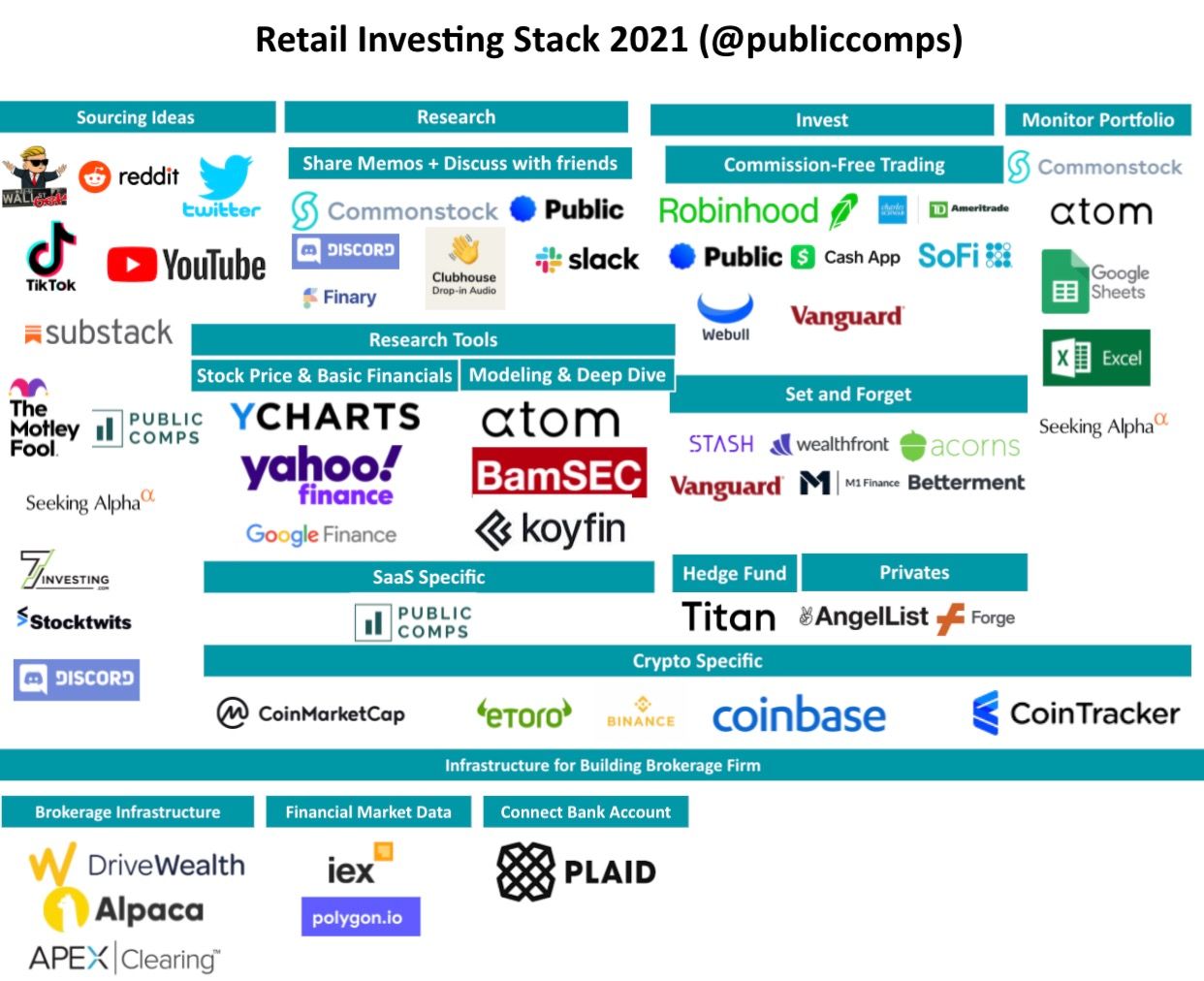
Let’s walk through the various segments of the retail investing stack
- Sourcing Ideas:
- Jobs to be done: Arguably the most important job to be done is helping the retail investor answer the question “what stocks should I buy” and "how can I make money". Retail investors are exchanging ideas in Slack, Discord, Whatsapp, Messenger groups and getting investment ideas also from social media channels like Reddit, Tik Tok, Youtube, and Twitter.
- Cutting through the noise: However, I’d argue one of the biggest problems is how do content creators and founders cut through the noise particularly those who are value or long term oriented investors. What if I don’t want to recommend investors to #YOLO day trade Tesla or Bitcoin on Robinhood and want a more thoughtful write up?
- Rise of Long Form Content: I’m pretty excited about the rise of investors sharing their knowledge publicly in long form content like Packy McCormick’s Not Boring substack that highlights the bear-case of Bill.com, Richard Chu’s write up of Teladoc, Muji @ hhhypergrowth’s deep teardown of the tech behind SaaS companies. Enabling the rise of long form content are platforms like Substack and Ghost.org that make it really easy to launch a blog out of the box quickly. Shout out to the amazing Albert Wang (@albertwang23) at Public Comps who posts bi-weekly newsletters tearing down businesses like Workday
- Online Investment Memos? What’d I’d love to see moving forward are full on investment memos with financial models, price targets along with a thesis, thoughtful analysis of the market, team, and product. I did this for Crowdstrike back in March 2020 (boy, did I underestimate their growth and valuation multiple!) but imagine this were consolidated into a single page. With attention spans decreasing and users wanting the answer “should I buy or not”, I think we’ll see more screen shot memos like what Nikhil Trivedi did with Canva:
2. Research: The lines blur a bit for research and sourcing but let’s define “research” as once an investor gets an idea and wants to dive more deeply into the company, they can discuss with their friends in Discord/Slack/iMessage/Messenger and start pulling up reports and doing their own analysis
- Social Communities: There are a lot of fascinating products that digitize and create structure and workflow for friends and strangers to discuss stock ideas. Finary.io is interesting because they’re a digital community for investors and building chat for friends where portfolios can be shared in real-time and trades executed in the product. Commonstock is also really fascinating because you can follow investors and see their historical returns and see whenever an investor makes a trade and the rationale behind each investment. We’ll cover a bit more in the trends part of the post but the shift to learning in public and sharing analysis & investment portfolios is here to stay and unlocks a lot of opportunities for founders.

- Research Tools for Analysis: Once an investor has an idea, and wants to do a deeper dive, we’ve seen users going into BamSEC, Koyfin, Atom.Finance to read earnings transcripts and to go through press releases and 10-k/10-Q. An opportunity for founders is summarizing 10-K/10-Qs -- BamSEC & Koyfin makes it simple to search and go through the filings easily but reading and getting insights takes time and effort especially for retail investors who also have day jobs.
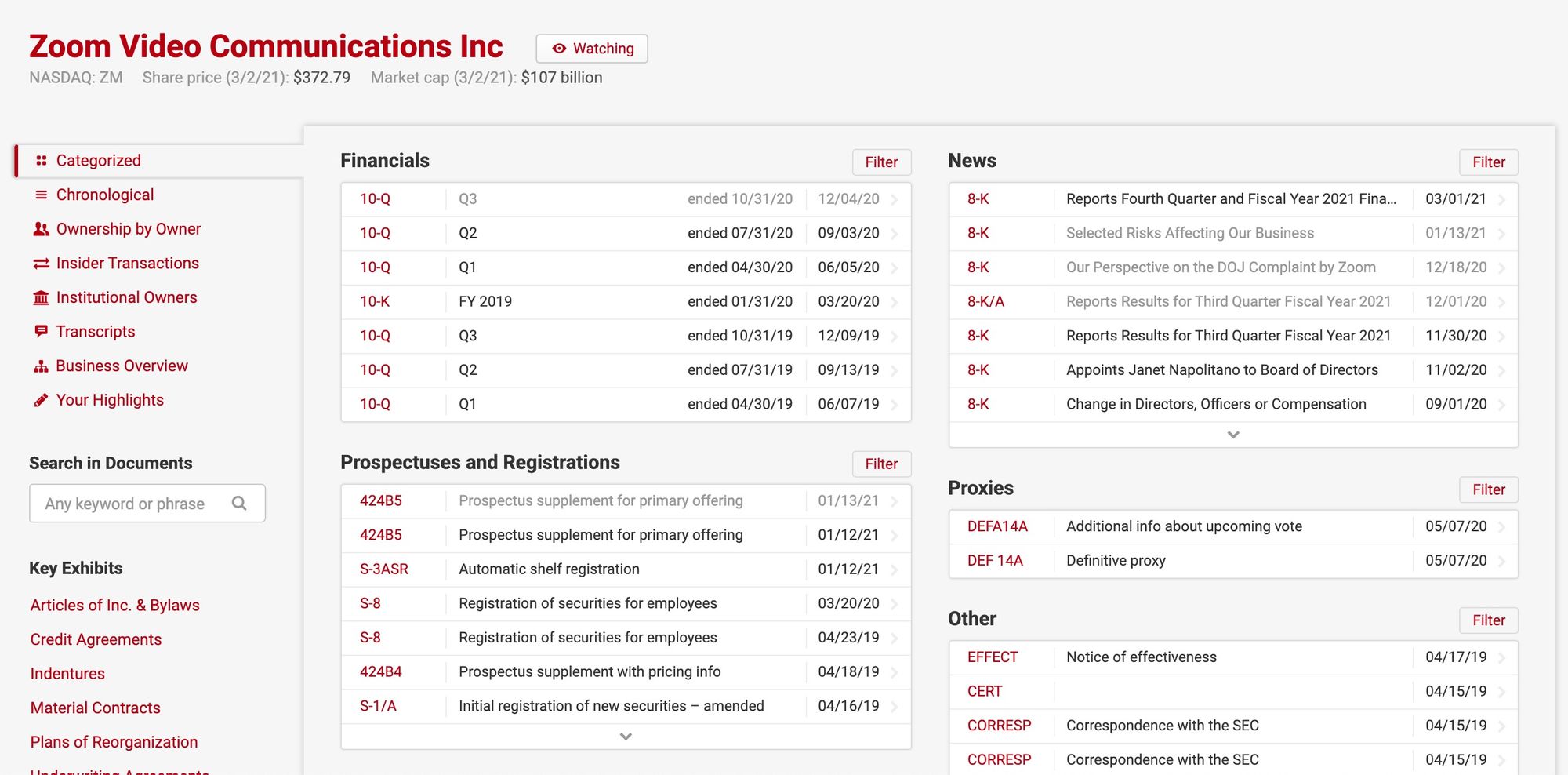
- Koyfin: We’re incredibly excited about companies like Koyfin that enable investors to get all the financial data and analysis they would need on public companies in one place and without having to open up Excel. For example, look at Microsoft in Koyfin -- you can see that Microsoft trades for ~30x PE and ~21x EV/EBITDA which seems quite reasonable given this environment and EPS growing 28% YoY!
- Atom Finance: Atom Finance also provides really slick tools to dive more deeply into a given company with historical financials, quarterly reports, historical consensus estimates, and even generate a simple model with their “Sandbox” feature.
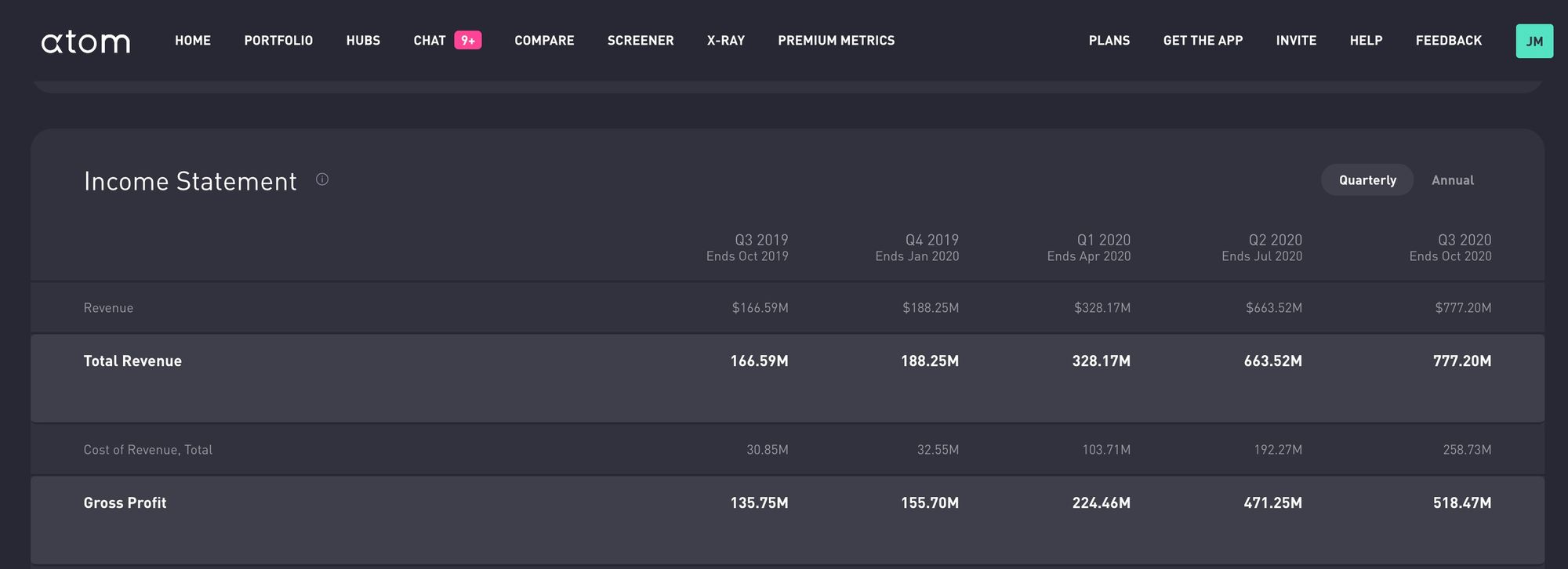
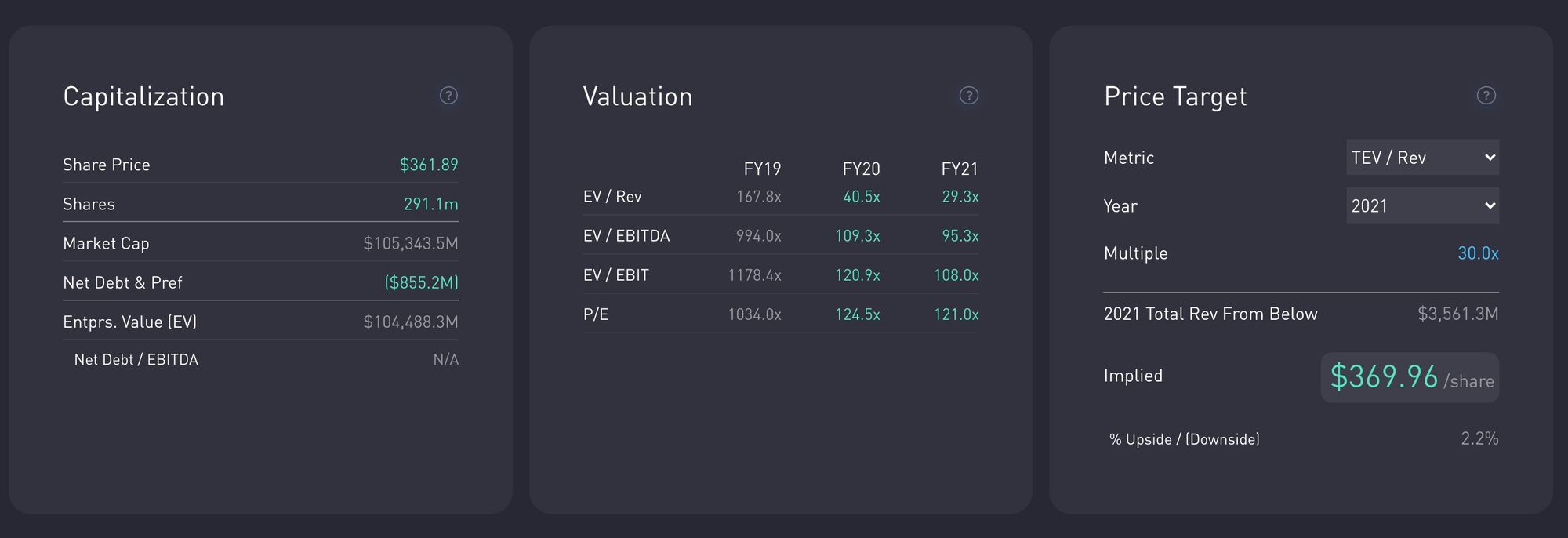
- Industry & Sector Specific: And then you have tools that are sector specific like yours truly’s startup Public Comps which provides SaaS specific metrics and analysis for Public Companies. I expect that we’ll see more vertical/industry specific products overtime on the content, research and discovery side. Our hot take is analyzing SaaS companies with a recurring revenue model with high retention rates is very different than analyzing biotech, consumer internet, and travel companies -- why should the tools be all the same?

3. Invest: once an investor has an idea, discusses it with their friends, does some research, the investor executes the trade depending on the investment strategy. Sometimes the sourcing, diligence, and research process is compressed to these investing platforms.
- Which brokerage account? What determines what products users use for investing? We think it's ease of use + user interface (this is where Robinhood’s mobile product really shines), educational content (answering the question “what should I buy”), fees (most brokerage products are now zero commission), and trust & brand (Robinhood’s outages in early 2020 hurt them here).
- Short Term vs Long Term Investing Accounts: Something we’ve heard from users is that they use their Robinhood accounts for their short term investments or for day trading but use Schwab, Fidelity, and other brokerage accounts for their long term investments they plan on buying and holding because of the ironic but added friction of buying & selling on Schwab, Fidelity, TD Ameritrade accounts.
- Long Term Investing Focus: Most brokerage products have zero commission trades and make most of their money from payment for order flow which incentives brokerages to maximize trading volume. However, it’s fascinating to see the narrative of more brokerage firms positioning themselves as helping investors be long term oriented investors: M1Finance allows users to continue to invest behind a basket of companies on a recurring basis and the founder explicitly stated M1’s mission to be a platform that encourages long term behavior. On February 21st, 2021 in light of the Robinhood + AMC/Gamestop trading controversy, Public.com said they officially ended their participation in payment for order flow and shifted to a tipping model. This begs the question: can brokerage dealers monetize and make money without payment for order flow for these brokerage companies? M1 Finance charges a $125/year subscription fee and makes money on interest & loans and Techcrunch estimates the business was at a $20m run rate revenue at their Series C. Even Robinhood claims their customers are investing for the long run: “Robinhood’s platform allows people from all backgrounds to invest, with no account minimums and zero commissions. Contrary to some very misleading and highly uninformed reports, we see evidence that most of our customers are investing for the long-term”
- Set & Forget: We view products like Titanvest, Wealthfront, Betterment, M1 Finance as different investment strategies but with the same theme of allowing users to link their bank accounts and continue to invest on a recurring basis into a basket of companies that are either actively managed by investors (Titanvest), a basket that users can select (M1 Finance) or pre-selected baskets by an algorithm depending on risk tolerance (Betterment, Wealthfront).
4. Monitor Portfolio: A common complain that came up from interviews was users wanting to centralize all their trading information into one one place based off of their trades in Robinhood, Schwab, Fidelity, M1 Finance, etc. Currently we’ve observed users doing this manually in Excel or Google Sheet. Atom Finance & Common Stock allow you to link your brokerage accounts using Plaid and to get an overview of your accounts and performance against a benchmark. Atom Finance is particularly interesting in sending out notifications ahead of earnings reports or large portfolio movements (+/- 5% share price in a day).
5 interesting trends in the retail investing space
- The rise of social media as sources of investment ideas
The pandemic moved conversations that used to be in-person around stock trading ideas around the dinner table and moved them online into WhatsApp, Slack, and Discord groups.
We've seen a massive uptake in investing interest across the social media platforms:
- Reddit: Reddit’s WSB user growth is exponential and grew from <1m in 2020 to over >5m in the last few months.
- Tik Tok: Tik Tok engagement has been up a ton as well – #investing has over 1.6b views up 60% in the last month.
Implications: Founders looking to market their products on Tik Tok and Twitter will need to find a balance of providing educational content that is also punchy and entertaining. For example, Robert Ross, an equity research analyst, does an awesome job talking through stocks like Tesla, Snowflake, Palantir and sharing the high level takeaways from his models while being very entertaining ("let's analyze!").
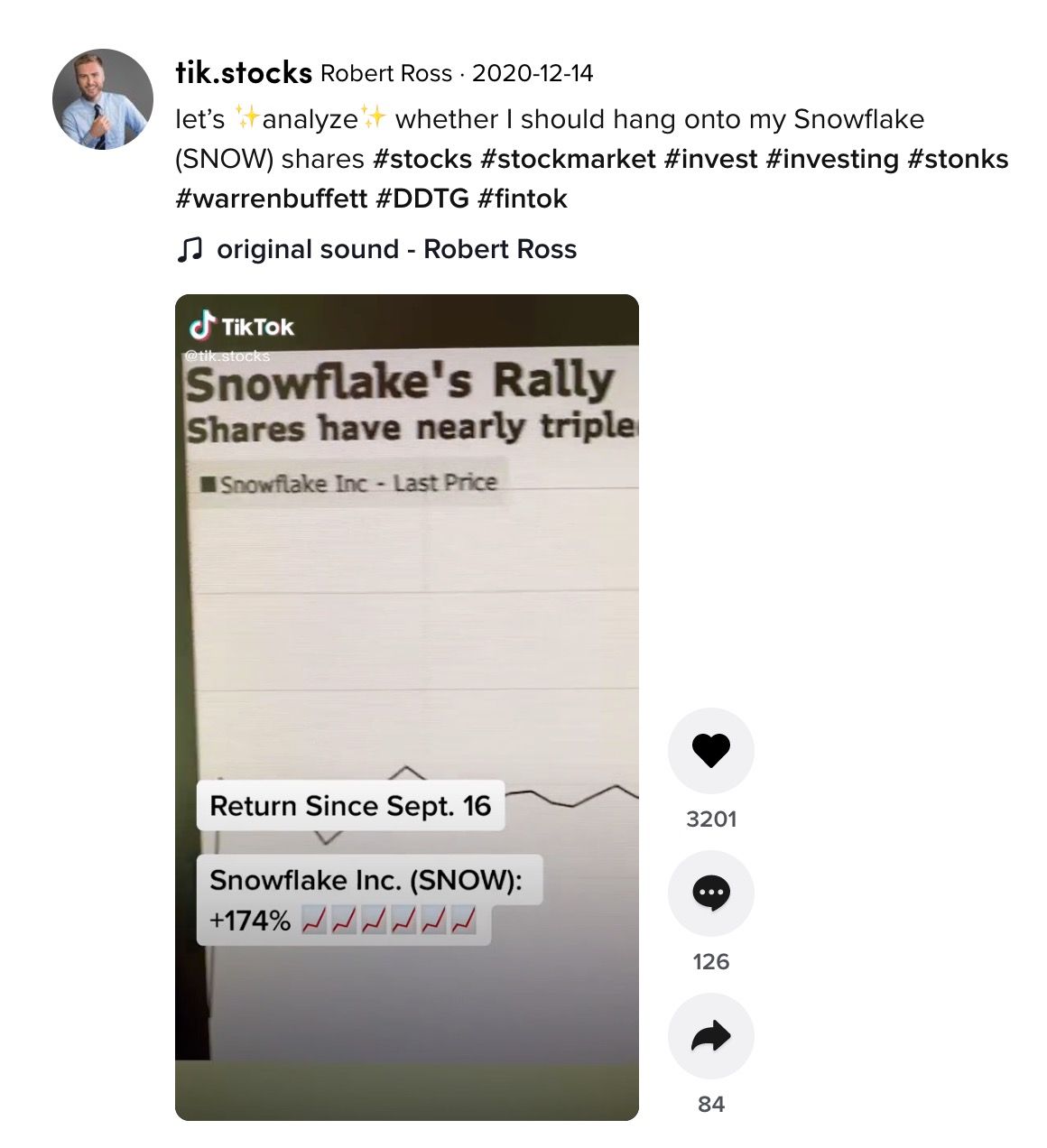
2. Follow and invest with investors who share their portfolios and rational behind their investments
"Don’t tell me what you think, tell me what you have in your portfolio." - Nassim Nicholas Taleb
It used to feel somewhat taboo to share your personal holdings for fear of making mistakes and being held accountable. However, more and more investors have realized sharing their portfolios readily builds credibility and sharing knowledge publicly about the why behind their holdings allows them to further build conviction or learn from others.
Richard Chu (@richard_chu97) is a consultant turned growth investor and posts his ideas and portfolio readily on Twitter. Here's an example from a recent tweet:
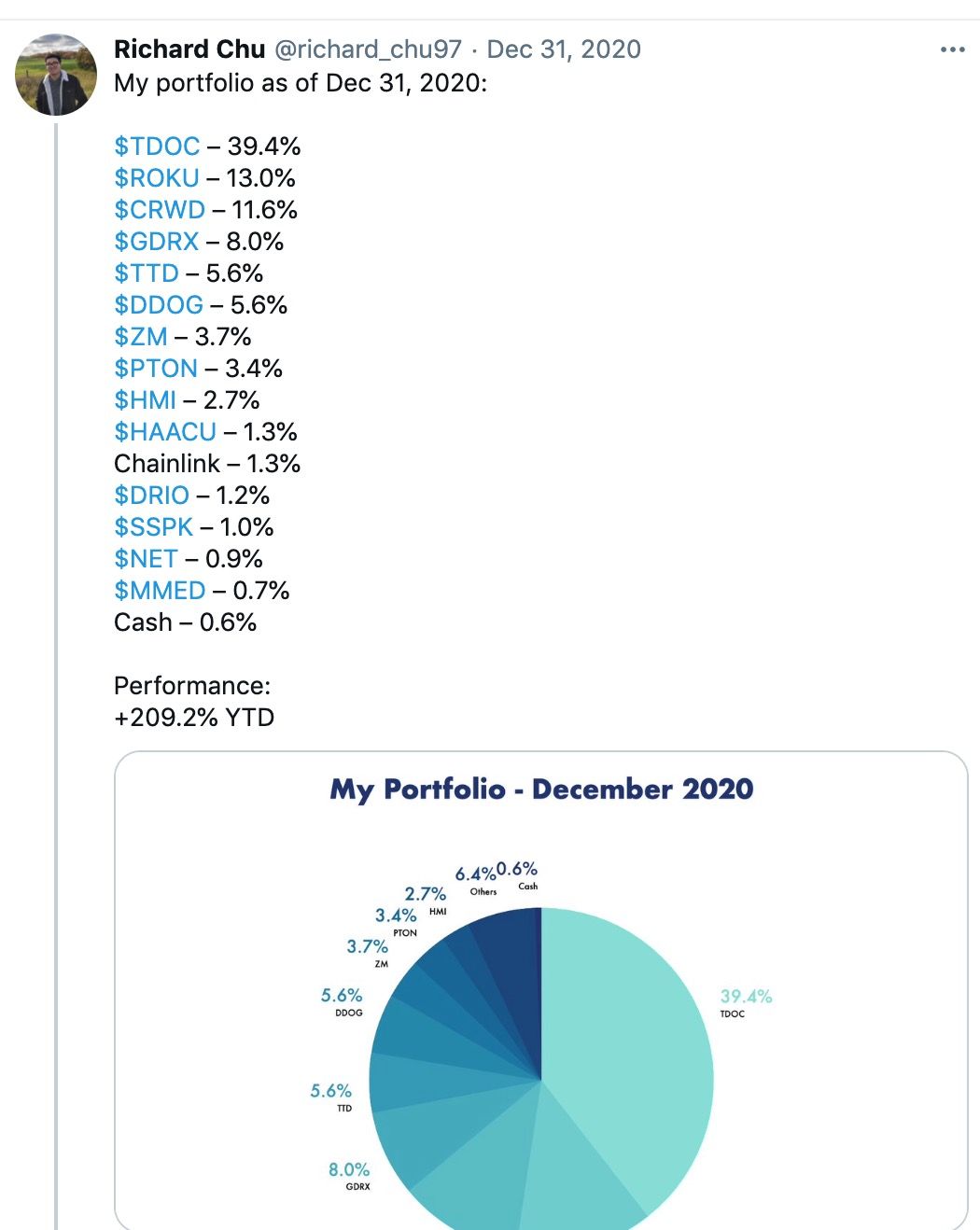
What's fascinating about Richard's portfolio is the heavy concentration he has in a single stock (Teladoc at ~40%) but also how much he covers and shares his thinking and research: https://richardchu97.substack.com/p/teladoc-health-reshaping-healthcare.
Peter Offringa at Software Investing Stack (@StackInvesting) similarly shares his rationales behind each of his investments and shares his personal portfolio publicly. Peter regularly goes through product and financial updates for each of his holdings like this teardown of Twilio's Q3'2020 earnings
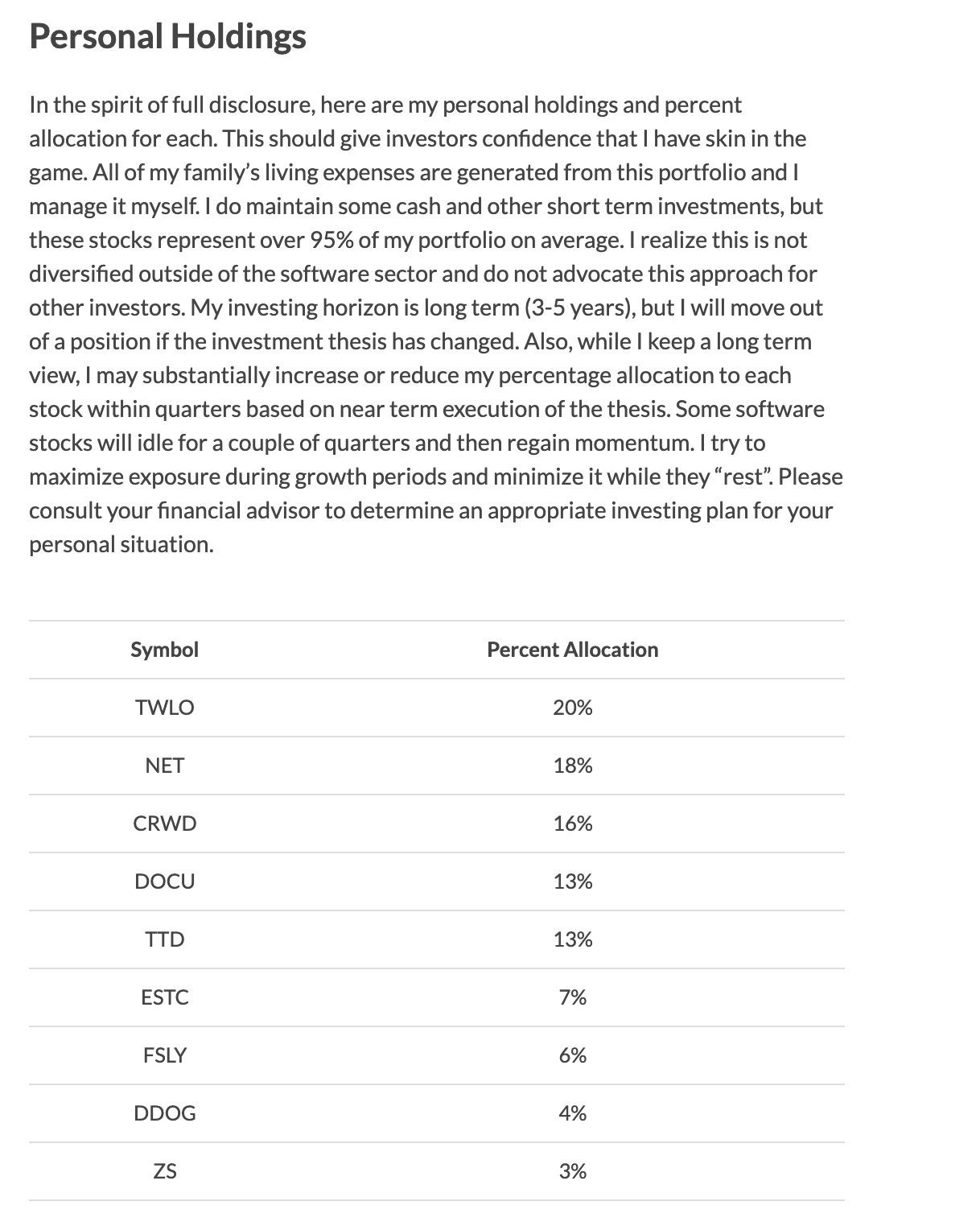
Commonstock is super fascinating in that by default users are sharing their returns and portfolio publicly so investors can choose to follow influencers that they trust or have the best returns. Commonstock automates what influencers are doing manually themselves of tracking the portfolio, posting it on Twitter and sharing their rationale behind each trade.
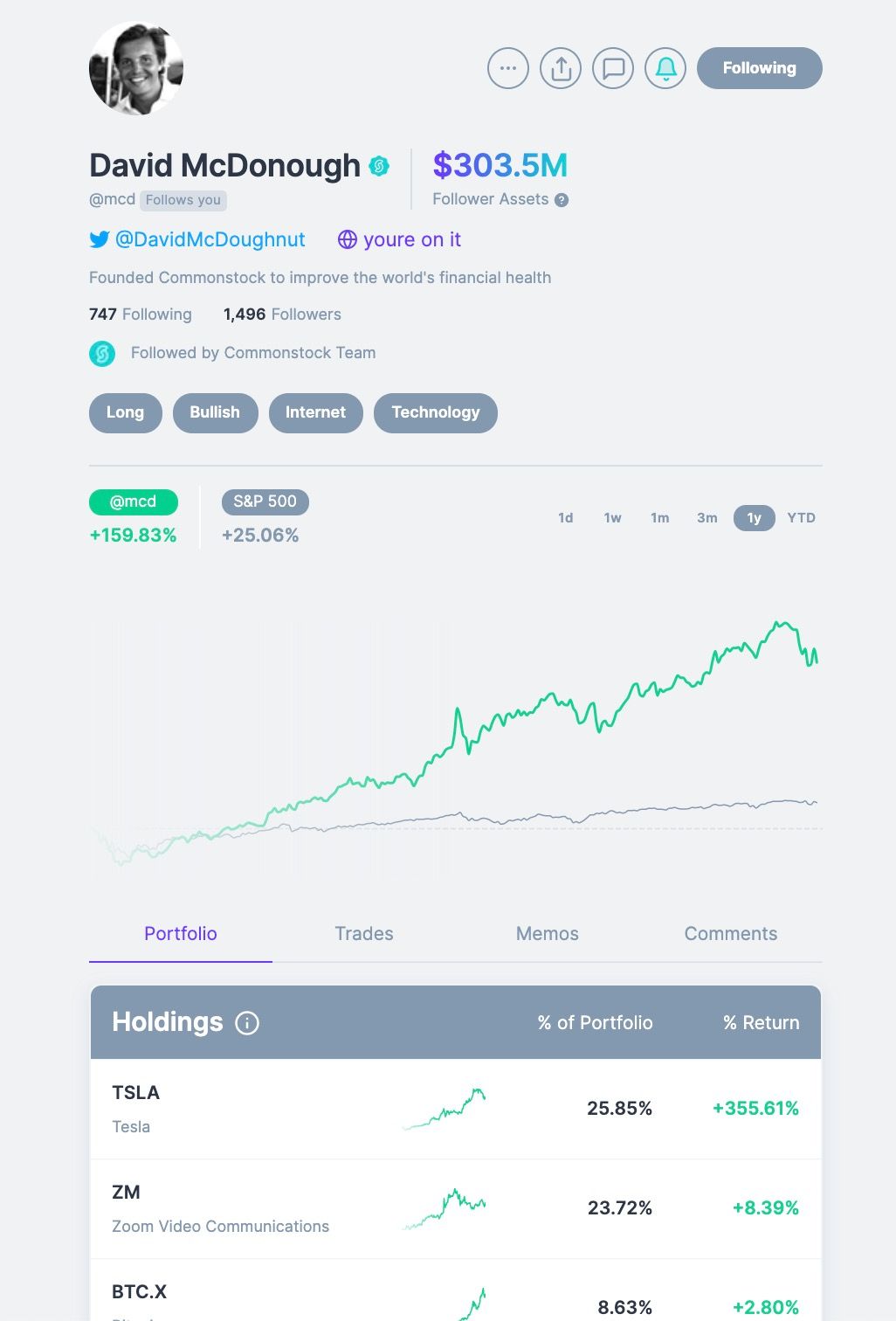
Opportunity: Ability to replicate an investor’s portfolio? It’ll be interesting if you can replicate the portfolio of an investor you respect and automatically buy the same basket of companies they own. You see companies like Doji starting to tackle this and we see companies like Commonstock as potentially best positioned to do this given they have creators + consumers on their social network and both sharing their investment holdings publicly.
3. The actively managed hedge fund for Millennials with lower fees
Titanvest is a highly intriguing company: launched in Fall of 2018, the business just raised a $12.5m Series A, has >$500m AUM, is profitable and grew 600% y/y in 2020.
The value to users is simple: we’re your investment team and you can invest in an actively managed hedgefund with as little as $100 and pay as little as $5/month. Additionally, Titan has a mobile product that is much easier to use and navigate than the reams of reports you get from investing in Blackrock or Fidelity's mutual funds.
Whereas traditional hedgefunds charge 2% management fee and 20% performance fees, Titan charges 1%.
Titanvest seems to be succeeding because it solves a core problem: if I have cash lying around and want expert advice, where should I invest the capital?
A question is why aren't there more Titanvest or D2C hedgefunds that are mobile friendly and easily accessible given that they're clearly great businesses.
One barrier of entry is proving you can actually pic well and having historical returns to point to: Titanvest has a strong track record and can point to beating the market.

4. More tools serving retail investors that bring Wall Street capabilities that are too expensive (think Bloomberg Terminals or CapIQ) to every day investors like Koyfin, Atom Finance, Public Comps
The lucky ones are the investors who during the day have a Bloomberg terminal or CapIQ account for work and are able to use the same platforms for investing.
However, most of us can’t afford the $24k/year for a Bloomberg terminal or $13k/year for a CapIQ license.
That’s why it's incredibly exciting to see companies like Koyfin & Atom Finance bringing the consumerized versions of these financial data products to the masses with MUCH better user interfaces (the charts are actually pretty!) in a web app form.
We had a similar thesis for Public Comps born out of not being able to afford CapIQ/Bloomberg as my previous venture role and having to manually spread comps and create valuation tables. A lot of our free users use Public Comps to screen for software companies to potentially research or invest in.
We think this trend will only accelerate: the modernization and consumerization of these research tools that were previously only available to Wall Street analysts so that you and I can dive deep and look at the historical financials in a few clicks of a button.
5. Buy and hold strategy
Warren Buffet once said “"Our Favorite Holding Period Is Forever." Patrick O'Shaughnessy of Invest With The Best shared an interesting tweet on his interest in a buy & hold oriented apps.
We think there’s a lot of opportunity in educating more investors to avoid actively day trading (sorry WSB!) and the benefits of buying and holding onto a basket of stocks.I’m reminded about the importance of just buying and holding whenever I look at the Bessemer Cloud Index:
The punchline is this: if you bought and held onto a basket of software stocks over the last 7.5 years, you would have made 11x your money which nets out to ~39% annualized returns.
What is very fascinating and worth exploring are what are the basket of companies and sectors that if you just held onto them and closed your eyes for 5-10 years, you’d allow investors to get above market returns? My bet? Still software and sectors still early on the adoption curve (payments, e-commerce, digital health, etc).
